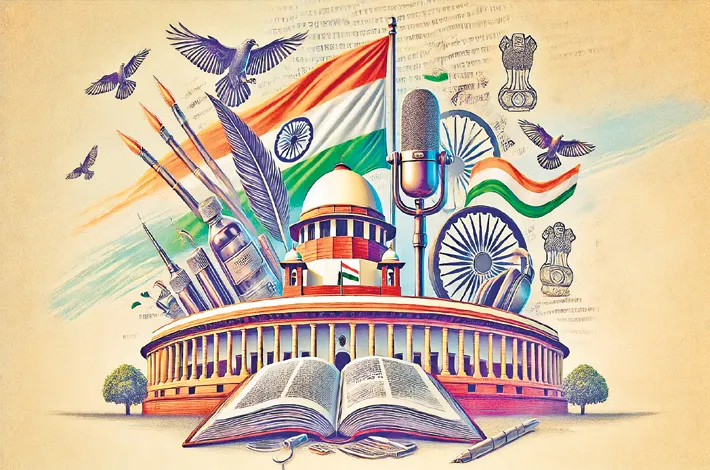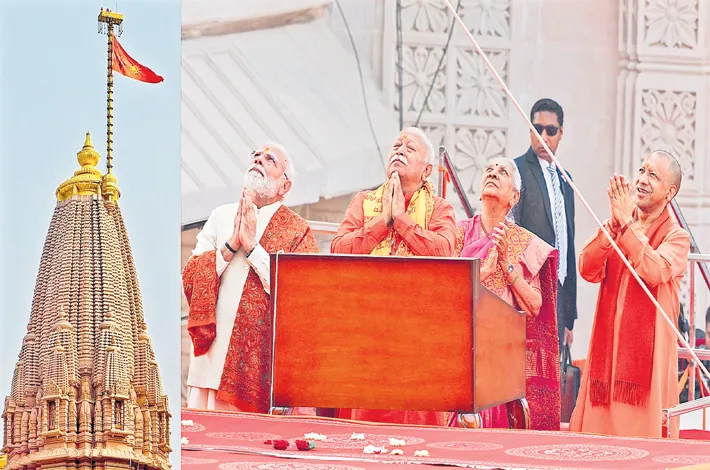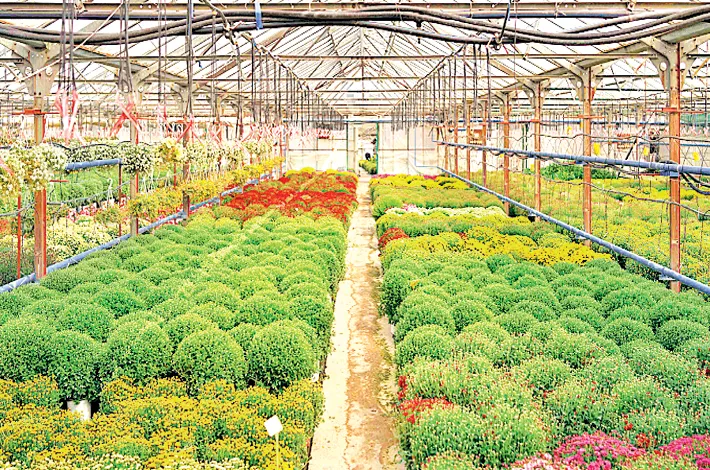National Constitution Day 2025 Celebrating resilience amid challenges
26-11-2025 12:00:00 AM

Civic Pulse
■ 38% of minorities feel insecure about rights
■ 48% of SC/ST students get reserved jobs
■ 35% of tribal land claims recognised
■ 43% of interfaith couples face barriers
■ India ranks 150th in press freedom
■ 1.1 million tribal claims rejected
■ 70,000+ cases pending in Supreme Court
■ 76% of urban women face welfare obstacles
■ 55% of transgender individuals get state support
■ 25% of rural citizens distrust legal protections
As India observes Constitution Day, the occasion prompts reflection on both the enduring strengths and evolving challenges of the nation’s supreme law. More than a legal document, the Constitution has become a dynamic site of debate, shaping public discourse and policy, influencing civil society, and reflecting the aspirations and anxieties of citizens across the country. While some argue that certain principles are under strain, others contend that its resilience continues to guide India through social, political, and judicial turbulence.
Over the past seven decades, India’s judiciary has repeatedly reinforced the Constitution’s core values. Landmark rulings such as Kesavananda Bharati (1973) upheld the inviolability of the Constitution’s basic structure, while Maneka Gandhi (1977) expanded protections of life and personal liberty. SR Bommai (1994) curtailed misuse of Article 356, and recent cases such as Shayara Bano (2017), Navtej Johar (2018), and Joseph Shine (2018) expanded dignity and personal freedoms.
In 2024, the Supreme Court’s judgment on electoral bonds and the sub-classification of SC/ST quotas underscored its continuing role as a check on power. At the same time, these rulings illustrate a gap between legal guarantees and lived experience, highlighting the role of political culture and institutional commitment in translating rights into reality.
Secularism, one of the Constitution’s foundational pillars, faces both challenges and reaffirmations. Laws such as the Citizenship Amendment Act 2019 and proposals for a nationwide NRC have generated anxiety among minority communities, particularly Muslims and Christians, who fear erosion of equal citizenship. Critics argue that defining citizenship on religious criteria undermines the constitutional promise of equality.
Yet defenders contend that India’s identity as a civilisational state allows for nuanced interpretations of secularism, reflecting historical and cultural realities. According to a 2024 Pew Research study, 38% of minority respondents reported insecurity about their rights, reflecting both perception and ongoing debates about inclusive governance.
Federalism, another core feature, has been tested by political developments such as the abrogation of Article 370 and interventions in state governments, including Maharashtra, Karnataka, and West Bengal. Proposed policies like “One Nation, One Election” and amendments to the Delhi Services Act have fueled concerns about central overreach. At the same time, proponents highlight the Constitution’s flexibility and capacity to balance regional autonomy with national integration. Dr Ambedkar’s vision of a “spacious” Constitution continues to allow room for debate, negotiation, and cooperative governance despite tensions between the Centre and states.
Reservation policies, the Constitution’s most ambitious social justice tool, illustrate both progress and ongoing challenges. The 103rd Amendment, introducing a 10% quota for the economically weaker sections (EWS) in the general category, breached the 50% ceiling but widened access to opportunities for economically disadvantaged upper castes. However, Dalit and Adivasi activists argue that these changes dilute affirmative action’s reparative intent.
Privatisation and contract employment have also reduced the pool of reserved jobs, and the “creamy layer” principle is being applied to SC/ST officers. Currently, only 48% of SC/ST students in central government jobs benefit from reservations, highlighting persistent gaps. Despite these challenges, the policy framework continues to provide opportunities for historically marginalised groups, ensuring that affirmative action remains a cornerstone of social justice.
Tribal communities highlight a mix of progress and unfinished work. The Forest Rights Act 2006 empowered adivasis to claim land rights, yet implementation remains uneven. Over 1.1 million claims were rejected by 2019, underscoring administrative challenges. Less than 35% of tribal forest land claims have been fully recognised.
Critics point to mismanagement and delays, while supporters emphasise that the legislation itself represents an unprecedented recognition of tribal rights, offering a legal pathway that was historically unavailable. The ongoing dialogue between conservation, development, and tribal rights reflects the Constitution’s capacity to mediate competing interests.
Gender justice in India presents another mixed picture. Legal reforms have abolished triple talaq, decriminalised adultery, and granted women the right to enter Sabarimala. Transgender persons were recognised as a third gender in 2014, although state-level welfare support remains limited. The decriminalisation of homosexuality in 2018 marked a landmark expansion of rights, though same-sex marriage is still unrecognised.
Meanwhile, laws in some states affecting interfaith marriages, often labelled “love jihad” laws, have sparked debate over the balance between protection and personal freedom. Surveys indicate that 43% of interfaith couples faced legal or social barriers in the past three years, reflecting ongoing friction between tradition, law, and individual rights.
Free speech, often called the “safety valve” of democracy, faces scrutiny but also demonstrates resilience. While journalists, academics, and activists have been detained under UAPA, and India ranked 150th in the 2025 World Press Freedom Index, public debate continues robustly in media, universities, and online platforms. Court interventions, including bail and judgements limiting overreach, show that institutions remain active, albeit under pressure. This tension illustrates that the Constitution continues to facilitate negotiation between security concerns and civil liberties.
The judiciary itself has strengths and limitations. Long case backlogs, the “sealed cover” system, and discretionary powers of the Chief Justice have raised questions about efficiency and independence. The pendency of over 70,000 cases in the Supreme Court demonstrates the pressure on judicial processes. Yet the same judiciary has delivered transformative judgments on privacy, LGBTQ+ rights, and social justice, reminding citizens that the rule of law continues to function as a cornerstone of governance.
Civil society, historically a guardian of constitutional ideals, has faced restrictions, including loss of FCRA licences and tighter campus regulations. Yet new voices—Dalit, Adivasi, Pasmanda Muslim, queer, and disability rights movements—are emerging, often outside traditional liberal frameworks, asserting claims to justice, recognition, and inclusion. Their activism signals that while challenges persist, the Constitution provides avenues for participation, dissent, and reform.
Three currents dominate the national debate. One perspective views majoritarian policies as testing the Constitution’s resilience, warning of possible erosion of civil liberties. A second sees recent reforms—including Article 370 abrogation, farm laws, CAA, and efforts toward Uniform Civil Code—as overdue corrections to an outdated framework. The third, rooted in Dalit, Bahujan, and indigenous activism, argues for deeper structural reform to deliver substantive social justice. A fourth, centrist perspective, emphasises the Constitution’s inherent resilience, pointing to historical reversals of overreach and progressive judgements as proof that institutions bend but do not break.
As India marks its 76th Constitution Day, the message is clear: the Constitution remains a living, contested text. Every article, every principle, invites discussion, interpretation, and renegotiation. Its strength depends not only on judges and politicians but on the engagement of millions of citizens committed to upholding equality, liberty, and justice. Key statistics underscore the stakes: 38% of minorities feel insecure about their rights, only 48% of SC/ST students benefit from reserved jobs, less than 35% of tribal land claims have been recognised, 43% of interfaith couples face barriers, and India’s press freedom rank fell to 150th in 2025.
Constitution Day 2025 reminds the nation that democracy is not merely a formal exercise but an ongoing practice. Challenges remain, but so do opportunities. The Constitution’s promise of inclusivity, dignity, and justice continues to inspire, even as citizens debate its meaning and application. India’s democratic experiment is tested daily, yet the dialogue itself is a testament to the enduring vitality of its constitutional framework.








